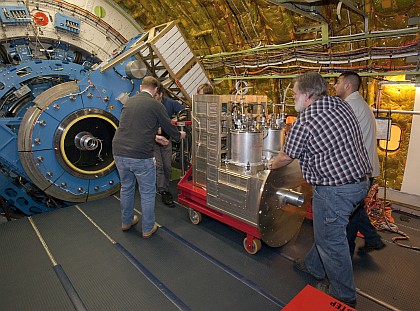
|
Press Release 4/2011
|
 |

|
Press Release 4/2011
|
 |
Press Release 4/2011 - February 1, 2011
On January 21st/22nd, 2011, GREAT, the "German Receiver for Astronomy at Terahertz Frequencies", was mounted on the airborne observatory SOFIA (Stratospheric Observatory for Infrared Astronomy) for the first time. Installation and first tests were very successful. A number of further tests will follow before the first scientific flights of SOFIA with GREAT will take place in April 2011. "Thanks to all who participated in the project over the years and contributed to the completion of the instrument", says Rolf Güsten from the Max Planck Institute for Radio Astronomy, project manager for GREAT.
GREAT, the "German Receiver for Astronomy at Terahertz Frequencies", is a receiver for spectroscopic observations at far-infrared frequencies between 1.2 and 5 Terahertz (60-220 µm wavelength), not accessible from ground because of water vapor absorption. The receiver will be used on the airborne observatory SOFIA. SOFIA is a joint project of the amerucan space agency NASA and the German Aerospace Center (DLR). GREAT has been built as one of two German SOFIA instruments of the first generation by a consortium of German research institutes (Max Planck Institute for Radio Astronomy in Bonn, University of Cologne, Max Planck Institute for Solar System Research in Katlenburg-Lindau, Institute for Planetary Research (DLR) in Berlin). Project manager for GREAT is Dr. Rolf Güsten from the Max Planck Institute for Radio Astronomy. The development of the instrument was financed by means of the participating institutes, the Max Planck Society, the and German Research Society within the framework of SFB 494.

|
|
Figure 3: GREAT on the forklift. Including the cart, almost 700 Kilogramms of delicate electronics have to be loaded with utmost care. |
|
(Credits: Foto: NASA Photo / Tom Tschida) |

|
|
Figure 4: GREAT approaching the telescope. |
|
(Credits: Foto: NASA Photo / Tom Tschida) |

|
|
Figure 5: GREAT in front of the telescope flange, waiting for final inspection and clearance. The pressure coupler inside the telescope tube is visible. |
|
(Credits: Foto: NASA Photo / Tom Tschida) |
Dr. Birgit Krummheuer
Press and Public Relations
Max Planck Institute for Solar System Research
Max-Planck-Straße 2
37191 Katlenburg-Lindau
Tel.: 05556 979 462
Fax: 05556 979 240
Mobil: 0173 3958625
Email: krummheuer![]() mps.mpg.de
mps.mpg.de
| © 2009, Max Planck Institute for Solar System Research, Lindau |
Presseinfo 01-02-2011 |